This easy step-by-step photo tutorial will teach you how to can applesauce in no time! Who knew it could be so easy? And homemade applesauce is the best!
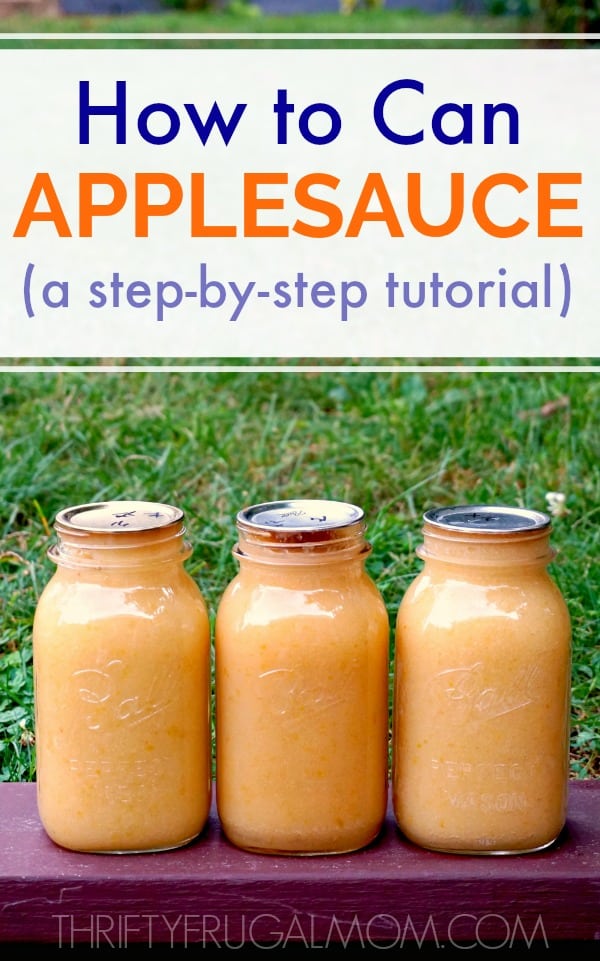
As a child, one of the things that I looked forward to each fall was helping my mom make applesauce to can and freeze.
My favorite part was turning the crank to the Victorio Strainer and watching as it separated the apple peels and seeds from the fleshy part of the apples to make homemade applesauce. It always felt almost magical!
Now I have the privilege of carrying on the tradition myself and it brings me so much joy to watch my own children experience the same fun that I had as we make homemade applesauce.
And I love that I get to continue a tradition that has been happening in my family since at least my great-grandmother, and probably much longer!
I preserve applesauce by both canning and freezing. Our favorite is the frozen because it tastes more like freshly made applesauce. Plus, we love the treat of eating it when it’s just slightly thawed. It’s so deliciously refreshing!
But of course, frozen applesauce also takes up a lot of freezer space, so I also end up canning applesauce too. Really, it’s quite tasty as well and it tastes about 1,000 times better than bought applesauce, for sure!
Want to learn how to can applesauce or freeze applesauce yourself? Let me walk you through the process of doing both.
Supplies for Canning Applesauce
There are affiliate links in this post. As an Amazon Associate, I earn from qualifying purchases. Please read my full disclosure policy.
- Apples (3 lbs., approx. 6 to 8 apples, of apples will give you around 1 qt. of applesauce)
- Sugar (optional)
- Dishpan or bowls to put the apples in
- Paring Knife
– this brand is my absolute favorite - Large kettle
- Long spoon to stir apples when cooking
- Ladle for transferring apples to jars
- Food Mill or Victorio Strainer
- Wide Funnel
- Damp cloth to wipe jar rims
- Small kettle for boiling jar lids
- Fork or Lid Wand
- Canner (or this Canning Rack may work depending on what size pot you already own)
- Canning jars with lids and bands
- Jar lifter
- Old towels or rags to set the hot jars on
How to Can Applesauce
3. Cook the apples
Dump your quartered apples into a kettle and add a small amount of water to it. I typically add water until there is about ½ in. of it in the bottom of the kettle. You basically just want a little bit of liquid in your kettle so that the apples don’t stick to the bottom as they start to cook.
Cook over medium heat until soft and mushy, approximately 15 to 20 minutes. (Should look like the picture above when they are done cooking). Stir occasionally, especially when beginning to cook, to prevent sticking.
4. Turn the apples into applesauce
At this point you two options for turning the cooked apples into applesauce. My picture shows the Victorio Strainer because that’s what I use to make my sauce. I love it because it’s super easy and does the job much more quickly than a Food Mill. But either one works.
If using a Victorio Strainer:
Fill the top part of the Victorio Strainer with cooked apples. Then turn the handle to push the apples through the sieve. This will remove the seeds and peels and give you a nice, smooth sauce.
If using a Food Mill:
Simply fill the food mill with the cooked apples and turn the handle to squeeze the apples and produce applesauce. Continue turning, occasionally reversing the direction to clean the apples off the bottom of the “pan”.
(If you want to see pictures of how the Food Mill works, check out my post on how to make tomato juice.)
5. Add sweetener to the applesauce
If desired, add sugar to sweeten your applesauce. Some apples are sweet enough that there is no need for this. We personally prefer the taste of homemade applesauce made with a tarter apple, so I always add sugar to taste.
A good rule of thumb is to add 1/8 cup per quart and then increase from there until it’s as sweet as you want it.
6. Pour the applesauce into canning jars
Pour your homemade applesauce into jars- a wide funnel makes this way less messy! The jar should be full to the base of the neck.
Wipe the rim of each jar with a damp cloth to remove any applesauce residue that may be there. (If there is even a slight bit of applesauce on it, it may not allow it to seal properly.)
Or if you want to freeze the applesauce instead of canning, simply pour the applesauce into freezer-safe containers, then once cooled, freeze. Remember to only fill containers about ¾ in. full to allow room for the applesauce to expand as it freezes.
If you are freezing your applesauce, this is your last step!
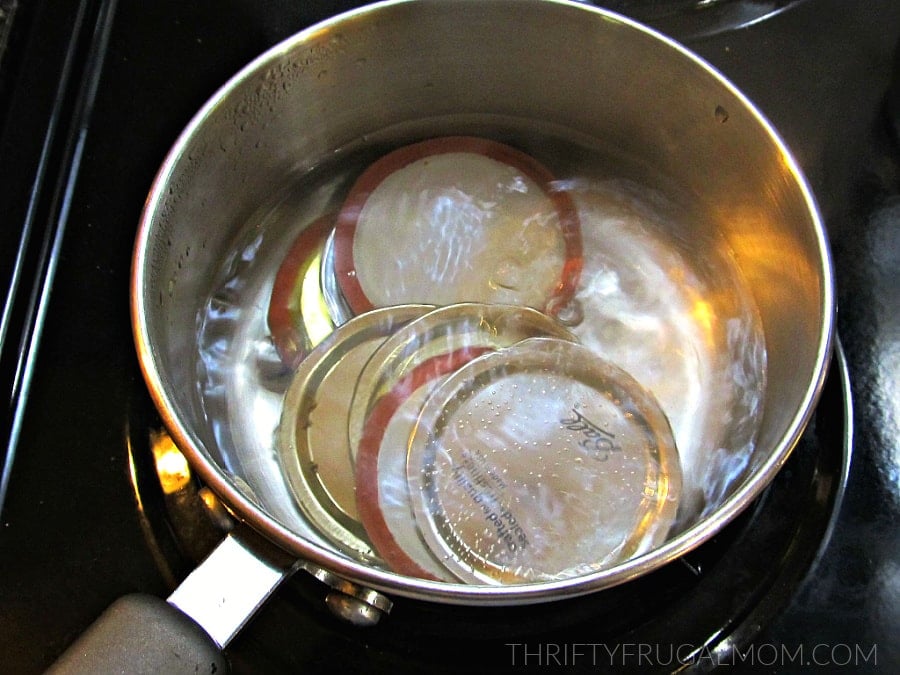
7. Add the jar lids and bands
Once you have 7 jars filled, place 7 metal canning lids in a small kettle. Cover with water; bring to a boil.
Once the water boils, use a fork to lift the jar lids out of the water- be careful not to burn yourself!- and place them on the jars. (You can also purchase a Lid Wand that uses a magnet to lift the lids more easily.)
Secure each lid with a jar band/ring. The reason for heating the lids is to soften the rubber, allowing for a better seal.
I read recently that some of the newer lids actually recommend that you don’t boil them, so you probably should double-check the instructions on the box of lids before doing this step.
8. Can the applesauce for 20 minutes
Place up to 7 canning jars of applesauce into the water bath canner. Fill the canner with enough hot water to cover the jars by 1 to 2 inches.
Turn the burner to medium-high heat. Once the water starts to boil, reduce the heat slightly and process both pints and quarts for 20 minutes. Make sure the water is boiling gently and steadily the whole time. You may need to adjust the heat to keep the boil going nicely, but really, as long as it is boiling, you are fine.
9. Remove from the canner…let cool
After processing for 20 minutes, turn the burner off. Remove jars using jar lifter- you may want to have a dishcloth in your other hand to catch any hot water that drips from the jars as you remove them- and place on an old towel, blanket or another padded surface. (The reason for doing this is to protect your countertop from the super hot jars.)
Allow at least a little bit of air space around each jar, making sure not to have jars close enough to touch. Do not move until jars are completely cool.
Jars should seal as they cool and you will typically hear a popping or pinging sound as the vacuum seal is formed. Lids will be slightly concaved when sealed.
To test the seal, lightly tap the center of the cooled jar lid. If it is firm and does not move, it should be sealed. If it pushes in, it didn’t seal properly. You can still use unsealed jars, just put them in the refrigerator and use them as soon as possible.
After jars are completely cool, you can remove the rings. Jars should be wiped clean before storing them.
Enjoy!
More home canning and freezing recipes:
How to Can Applesauce
Equipment
- Dishpan or container to put cut up apples in
- Paring Knife
- Kettle for cooking apples
- Spoon to stir the apples
- Wide Funnel
- Damp cloth to wipe jar rims
- Fork or lid wand
- Food Mill or Victorio Strainer
- Ladle
- Canner
- Canning jars with lids and bands
- Jar lifter
- Old towels or rags to set the hot jars on
- Various other containers and pans for holding the finished applesauce etc.
Ingredients
- Apples (3 lbs., approx. 6 to 8 apples, of apples will give you around 1 qt. of applesauce)
- Sugar optional
Instructions
- Remove stems and the blossom end of apple (this is on the bottom end of the apple in case you are confused), as well as any defective spots, then cut into quarters. You do not need to peel or core the apples.
- Wash quartered apples well. I simply fill a dishpan full of apples with water and then after swishing them around a bit, I’ll take a handful of apples and rinse them under running water. I continue doing this until all the apples are washed.
- Dump your quartered apples into a kettle and add a small amount of water to it. I typically add water until there is about ½ in. of it in the bottom of the kettle. You basically just want a little bit of liquid in your kettle so that the apples don’t stick to the bottom as they start to cook.Cook over medium heat until soft and mushy, approximately 15 to 20 minutes. (Should look like the picture in my blog post when they are done cooking). Stir occasionally, especially when beginning to cook, to prevent sticking.
- At this point you two options for turning the cooked apples into applesauce: a Victorio Strainer or a Food Mill. I prefer using the Victorio Strainer because it’s super easy and does the job much more quickly than a Food Mill. But either one works. VICTORIO STRAINER:Fill the top part of the Victorio Strainer with cooked apples. Then turn the handle to push the apples through the sieve. This will remove the seeds and peels and give you a nice, smooth sauce. (Be sure to place containers in the appropriate places to catch both the applesauce and the discarded peels and seeds that come out of the strainer.)FOOD MILL:If you are using a Food Mill, place it over a kettle or bucket and then fill the food mill with the cooked apples. Turn the handle to squeeze the apples and produce applesauce. Continue turning, occasionally reversing the direction to clean the apples off the bottom of the “pan”. (If you want to see pictures of how the Food Mill works, check out my post on how to make tomato juice.)Once all the applesauce is extracted from the apples, discard the peels etc. that are left in the food mill and continue with your next batch.
- If desired, add sugar to sweeten your applesauce. Some apples are sweet enough that there is no need for this. We personally prefer the taste of homemade applesauce made with a tarter apple, so I always add sugar to taste.A good rule of thumb is to add 1/8 cup per quart and then increase from there until it’s as sweet as you want it.(I usually just pour all the applesauce into a big dishpan, add sugar, mix and then taste test and continue adding sugar until the applesauce is sweetened to my liking.)
- Pour your homemade applesauce into jars- a wide funnel makes this less messy! The jar should be full to the base of the neck.
- Wipe rim of each jar with a damp cloth to remove any applesauce residue that may be there. (If there is even a slight bit of applesauce on it, it may not allow it to seal properly.)
- Once you have 7 jars filled, place 7 metal canning lids in a small kettle. Cover with water; bring to a boil. Once water boils, use a fork to lift the jar lids out of the water- be careful not to burn yourself!- and place them on the jars. (You can also purchase a Lid Wand that uses a magnet to lift the lids more easily.) Secure each lid with a jar band/ring. (The reason for heating the lids is to soften the rubber, allowing for a better seal.) I read recently that some of the newer lids actually recommend that you don’t boil them, so you probably should double check the instructions on the box of lids before doing this step.
- Place up to 7 jars in canner. Fill with enough hot water to cover the jars by 1 to 2 inches. Turn burner on medium high heat. Once the water starts to boil, reduce heat slightly and process both pints and quarts for 20 minutes. Make sure the water is boiling gently and steadily the whole time. You may need to adjust heat to keep the boil going nicely, but really, as long as it is boiling, you are fine.
- After processing for 20 minutes, turn burner off. Remove jars using jar lifter- you may want to have a dishrag in your other hand to catch any hot water that drips from the jars as you remove them- and place on an old towel, blanket or other padded surface. (The reason for doing this is to protect your counter top from the super hot jars.) Allow at least a little bit of air space around each jar, making sure not to have jars close enough to touch. Do not move until jars are completely cool.
- Jars should seal as they cool and you will typically hear a snap or pinging sound as the vacuum seal is formed. Lids will be slightly concave when sealed. To test the seal, lightly tap the center of the cooled jar lid. If it is firm and does not move, it should be sealed. If it pushes in, it didn’t seal properly. You can still use unsealed jars, just put them in the refrigerator and use them as soon as possible.After jars are completely cool, you can remove the rings. Jars should be wiped clean before storing.
Notes
If you prefer to freeze the applesauce instead of canning, simply pour the applesauce into freezer safe containers, then once cooled, freeze. Remember to only fill containers allow about ¾ in. full to allow room for the applesauce to expand as it freezes.



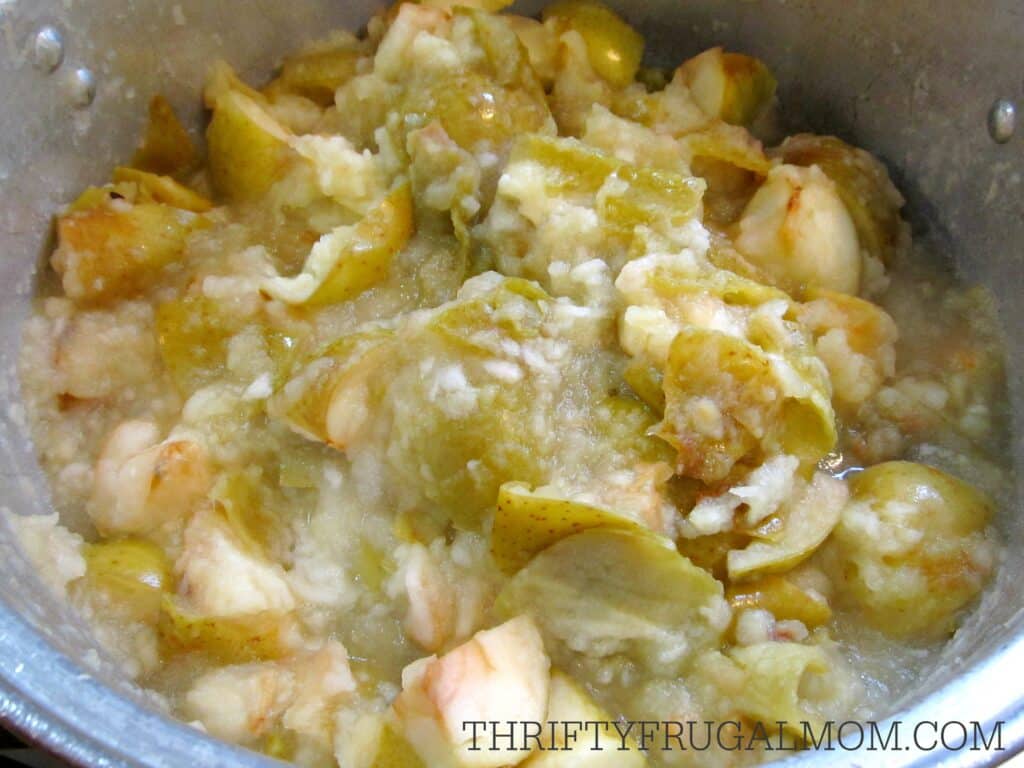

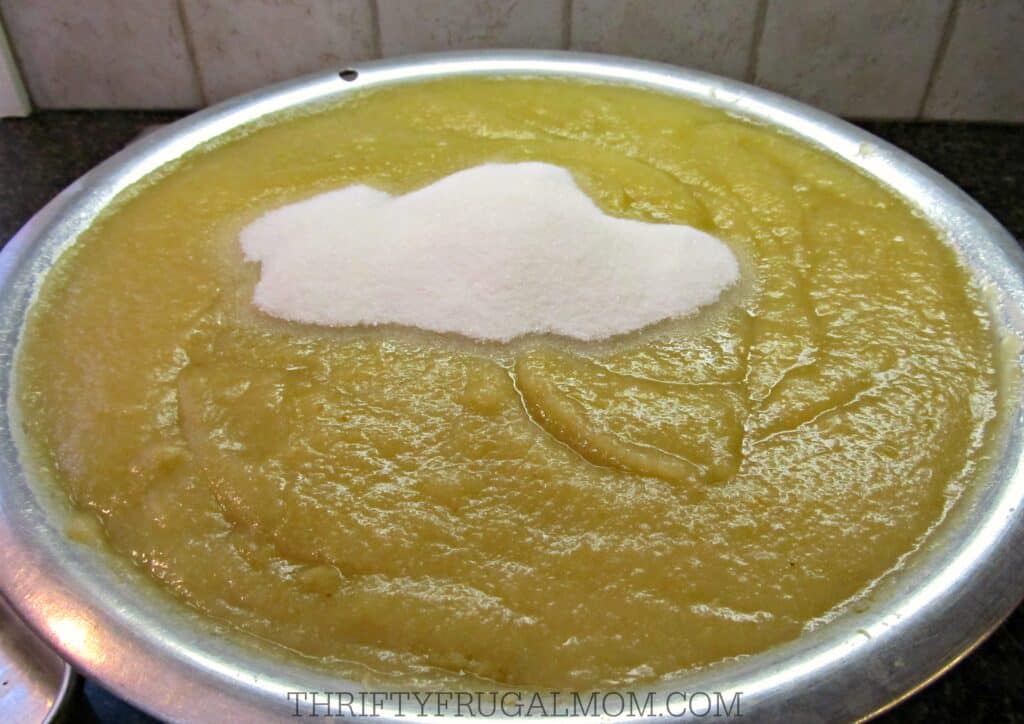


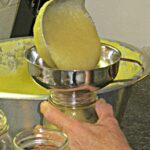

Silke
I just made a large batch of apple sauce in small mason jars as a baby gift. a quarter of my jars have popped open now over a period of 2 weeks. Now I remember why I stopped canning applesauce and only froze it. If I could just figure out what I did wrong???? I very much follow your instructions as well.
Lydia Beiler
What a fun baby gift idea! But how absolutely frustrating that they keep unsealing. Some of the main culprits for jars unsealing are the rim of the jar not being clean when you put the lid on or the ring being too tight (it should just be tightened until snug and secure but not really tight). And I assume you aren’t high altitude? If so, the canning time would need to be adjusted. Whatever the case, I’m really sorry. It’s so discouraging to see all the hard work go to waste!
Jo H
It looked like you didn’t boil your applesauce before filling the jars and then processing. Is that correct? I thought you had to boil it first. Otherwise, I love your method.
Lydia Beiler
That is correct.
Kristy
Gets a tip for saving freezer space when freezing applesauce. Freeze it in zipper freezer bags, lay it flat in the freezer. Once it’s frozen you can then stack them out place then on end in a plastic container or even a small box that is the width of the bags. These boxes can be stacked on top of each other. I also do this with the sweet corn I freeze and pretty much every thing else I freeze in bags.
Lydia Beiler
Yes, if you don’t mind using freezer bags, that works really well! Good tip! I find freezer bags a bit tricky for more liquid type of things like this and prefer using boxes or freezer safe containers. But they do take up a bit more space.
Jalissa Good
What kind of apples do you use
Lydia Beiler
I have used a variety of apples over the years. I used to use Smokehouse a lot (a tart variety similar to Granny Smith or Summer Rambo and found mainly in the area we lived in at the time). But then I switched to mostly using Cortland. I liked the flavor a lot and also was a fan of not needing to use as much sugar as I did with the Smokehouse.
Janice
is it okay to freeze applesauce in large quantities to be canned later? I don’t have time right now, but I’ve made the applesauce and really prefer to can it rather than freeze it.
Lydia Beiler
I wouldn’t know why it would hurt to do it this way. I would just make sure the applesauce is fully thawed before you can it. Also, if it’s quite cold when you put it in the jars, it may cause jar breakage when you heat the jars to can them, so it would probably be a good idea to let it warm up a bit or you could also just heat the jars very slowly so they can adjust to the temperature, if that makes sense.